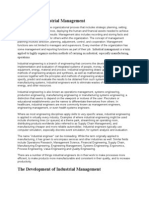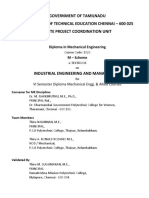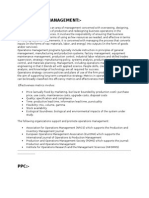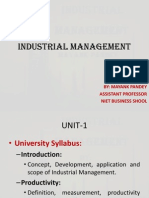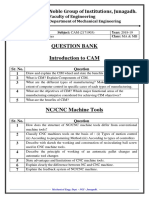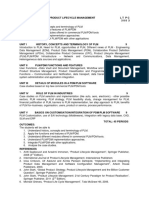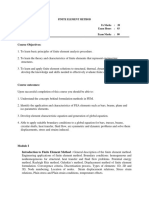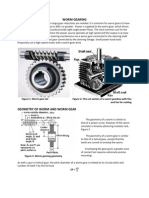Industrial Management
Industrial Management
Uploaded by
neeraj_3sharmaCopyright:
Available Formats
Industrial Management
Industrial Management
Uploaded by
neeraj_3sharmaCopyright
Available Formats
Share this document
Did you find this document useful?
Is this content inappropriate?
Copyright:
Available Formats
Industrial Management
Industrial Management
Uploaded by
neeraj_3sharmaCopyright:
Available Formats
120
6.1 INDUSTRIAL MANAGEMENT
L T P
3 - -
RATIONALE
The knowledge of this subject is required of all diploma holders who wish to choose
industry/field as this career. This course is designed to develop understanding of various
functions of management, role of workers and engineers and providing knowledge about
safety and labour, industrial laws and management in different areas.
DETAILED CONTENTS
1. Principles of Management (2 hrs)
Management, different functions of management: Planning, organizing,
coordination and control.
Structure of an industrial organization.
Functions of different departments. Relationship between individual
departments.
2. Human and Industrial Relations (4 hrs)
Human relations and performance in organization.
Understand self and others for effective behaviour.
Behaviour modification techniques.
Industrial relations and disputes.
Relations with subordinates, peers and superiors.
Characteristics of group behaviour and trade unionism.
Mob psychology
Grievance, handling of grievances.
Agitations, strikes, lockouts, picketting and gherao
Labour welfare.
Workers’ participation in management.
3. Professional Ethics (4 hrs)
Concept of ethics.
Concept of professionalism.
Need for professional ethics.
Code of professional ethics.
Typical problems of professional engineers.
Professional bodies and their role.
4. Motivation (4 hrs)
Factors determining motivation
Characteristics of motivation.
121
Methods for improving motivation.
Incentives, pay, promotion, rewards.
Job satisfaction and job enrichment.
5. Leadership (4 hrs)
Need for leadership.
Functions of a leader.
Factors for accomplishing effective leadership.
Manager as a leader.
6. Human Resource Development (4 hrs)
Introduction.
Staff development and career development.
Training strategies and methods
7. Wage Payment (4 hrs)
Introduction
Classification of wage payment scheme.
8. Labour, Industrial and Tax Laws (4 hrs)
Importance and necessity of industrial legislation.
Types of labour laws and disputes.
Brief description of the following Acts: The Factory Act 1948; Payment of
Wages Act 1936; Workmen Compensation Act 1923; Industrial Dispute Act
1947; Employee’ State Insurance Act, 1948; Provident Fund Act.
Various types of Taxes-Production Tax, Local Tax, Sales Tax, Excise Duty,
Income Tax.
Labour Welfare schemes.
9. Accidents and Safety (4 hrs)
Classification of accidents; according to nature of injuries i.e. fatal,
temporary; according to event and according to place.
Causes of accidents-psychological, physiological and other industrial hazards.
Effects of accidents.
Accidents-prone workers.
Action to be taken in case of accident with machines, electric shock, road
accident, fires and erection and construction accidents.
Safety consciousness & publicity.
Safety procedures.
Safety measures-Do’s and don’ts & good housekeeping (5S).
Safety measures during executions of Electrical Engineering works.
10. Environmental Management (4 hrs)
Basics of environmental pollution, various management techniques for control of
environmental pollution, various control acts for air, water, solid waste and noise.
122
11. Materials Management (4 hrs)
Material in industry, inventory control model, ABC Analysis, Safety stock, Re-
order, level, Economic ordering quantity, Stores equipment, Stores records,
purchasing procedures, purchase records, Bin card, Cardex, Material handling,
Manual lifting, Hoist, Cranes, conveyors, trucks, fork trucks.
12. Financial Management (3 hrs)
Important, ledger, Journal, Profit and Loss Account, Balance Sheet, Interpretation
of Statements, Ration Analysis, Project financing, Project appraisal, return on
investments.
13. Marketing and Sales (3 hrs)
Sellers and Buyers markets, Marketing, Sales, Market conditions, monopoly,
oligraphy, perfect competition, Cost Elements of Cost, Contribution, Break even
analysis, Budgets, Pricing Policies.
RECOMMENDED BOOKS
1. Industrial Engineering and Management by TR Banga.
2. Industrial Engineering and Management by OP Khanna, Dhanpat Rai Publications,
Delhi.
3. Industrial Management by VK Sharma, OP Harkut.
4. Sharma BR, Environmental and Pollution Awareness: Satya Prakashan, New Delhi.
5. Thakur Kailash, Environment Protection Law & Policy in India: Deep & Deep
publication, New Delhi.
6. Handbook of Small Scale Industry by P.M. Bhandari.
7. Marketing Management by Philip Kotler, Prentice Hall of India, New Delhi
8. Principles of Management by Philip Kotler, TEE Publication.
9. Industrial Organisation and Management by Tara Chand, Nem Chand and Brothers,
Roorkee
123
6.2 INSPECTION AND QUALITY CONTROL
L T P
3 - 2
RATIONALE
Diploma holders in this course required to measure and inspect for ensuring quality of
product. For this purpose, knowledge and skills about standards of measurement, limits,
fits and tolerances, types of inspection and various measuring instruments, SQC &
quality standards are necessary. Hence this subject.
DETAILED CONTENTS
1. Inspection (8 hrs)
Introduction, units of measurement, standards for measurement and
interchangeability.
International, national and company standard, line and wavelength standards.
Limits fits and tolerances: study of natural variability of process. Indian standards
on limits, fits and tolerances including terminology, guide for selection of fits,
clearance, transition and interference. Positional tolerances: maximum material
condition usage of standards for deciding tolerance.
Planning of inspection: what to insect? When to inspect? Who should inspect?
Where to inspect?
Types of inspection: remedial, preventive and operative inspection, incoming, in-
process and final inspection.
Study of factors influencing the quality of manufacture.
2. Measurement and Gauging (18 hrs)
Basic principles used in measurement and gauging, mechanical, optical, electrical
and electronic.
Study of various measuring instruments like: calipers, micrometers, dial
indicators, surface plate, straight edge, try square, protectors, sine bar, clinometer,
comparators – mechanical, electrical and pneumatic. Slip gauges, tool room
microscope, and profile projector, talysurf.
Limit gauges: plug, ring, snap, taper, thread, height, depth, form, feeler, wire and
their applications for linear, angular, surface, thread and gear measurements,
gauge tolerances.
Geometrical parameters & errors:
Errors & their effect on quality, concept of errors, measurement of geometrical
parameter such as straightness, flatness & parallelism.
Study of procedure for alignment tests on lathes, drilling and milling machines.
Testing and maintenance of measuring instruments.
3. Statistical Quality Control (12 hrs)
Basic statistical concepts, empirical distribution and histograms, frequency, mean,
mode, standard deviation, normal distribution, binomial and Poisson (No
mathematical derivations).
Introduction to control charts, namely X, R, P and C charts and their applications.
124
Sampling plans, selection of sample size, method of taking samples,
frequency of samples.
Inspection plan format and test reports
Concept of total quality management (TQM)
4. Standards and Codes (4 hrs)
National and International Codes.
ISO-9000, concept and its evolution and implications.
5. Instrumentation (6 hrs)
Measurement of mechanical quantities such as displacement, vibration,
frequency, pressure temperature, humidity by electro mechanical
transducers of resistance, capacitance & inductance type.
LIST OF PRACTICALS
1. Use of dial indicator for measuring taper.
2. Use of combination set, bevel protector and sine bar for measuring taper.
3. Measurement of thread characteristic using vernier and gauges.
4. Measurement of all elements of gauges by using flange micrometer, gear roller
tester, gear tooth vernier and profile projector.
5. Use of slip gauge in measurement of center distance between two pins.
6. Use of tool maker’s microscope and comparator.
7. Verify that when random samples are taken from a universe with a certain
percentage of defectives same percentage tends to appear in random samples by
using (Shewart’s plastic kit box).
8. Plot frequency distribution for 50 turned components.
9. With the help of given data, plot X, R, P and C charts.
LIST OF RECOMMENDED BOOKS
1. Statistical Quality Control by M.Mahajan: Dhanpat Rai and Sons, Delhi
2. Engineering Metrology by RK Jain
3. Engineering Metrology by RK Rajput; SK Kataria and Sons
4. Production Planning Control and Management by KC Jain & Aggarwal; Khanna
Publishers, New Delhi
125
6.3 AUTOMOBILE ENGINEERING
L T P
3 - 2
RATIONALE
These days, automobiles has become a necessity instead of luxury. There has
been phenomenal development of Automobile industry. The Diploma holders in
Mechanical Engineering are required to supervise production and repair and
maintenance of vehicles. For this purpose, knowledge and skills are required to be
imparted to them regarding automobile industry as a whole. This subject aims at
developing required knowledge and skills in this area:
DETAILED CONTENTS
1. Introduction (4 hrs)
Components of an automobile
Classification of automobiles
Layout of chassis
Types of drives-front wheel, rear wheel, four wheel, left hand, right hand
2. Transmission System (12 hrs)
Clutch Function, Constructional details and working of single plate and
multiplate friction clutches, Centrifugal and semi centrifugal clutch
Gear Box – Function, construction and working of sliding mesh, constant mesh
and synchromesh gear box, Torque converter and overdrive, fluid coupling
Function of Universal joint, propeller shaft, Function and construction of
differential, Rear axle drives. Function of rear axle and different types of rear
axles
Wheels and Tyres-Types of wheels - disc wheels and wire wheel, Types of
tyres used in Indian vehicles, Toe in, toe out, camber, caster, kingpin inclination,
Tubeless tyres
3. Steering System (5 hrs)
Function and principle
Ackerman and Davis steering gears
126
Types of steering gears - worm and nut, worm and wheel, worm and
roller, rack and pinion type
4. Braking system (5 hrs)
Constructional details and working of mechanical, hydraulic and vacuum brake
Details of master cylinder, wheel cylinder
Concept of brake drum, brake lining and brake adjustment
5. Suspension System (4 hrs)
Function
Types
Working of coil spring, leaf spring Shock absorber
Shock absorber
6. Battery (6 hrs)
Constructional details of lead acid cell battery
Specific gravity of electrolyte - effect of temperatures on specific gravity
Capacity and efficiency of battery
Battery charging, chemical reactions during charge and discharge.
Maintenance of batteries
Checking of batteries for voltage and specific gravity
7. Dynamo and Alternator (6 hrs)
Dynamo - Function and details, Regulators - voltage current and compensated
type, Cutout - construction, working and their adjustment
Alternator-Construction and working, Charging of battery from alternator
8. Diagram of a Typical Wiring System (2 hrs)
127
9. Lighting System and Accessories (4 hrs)
Lighting system
Wiring circuit
Headlight, aiming of headlights
Lighting switches
Direction indicators
Windscreen wiper
Horn
Speedometer
Heater
Air conditioning
LIST OF PRACTICALS
1. Fault and their remedies in (i) Battery Ignition system (ii) Magneto Ignition
system
2. Study and sketch of (i) Head Light Model (ii) Wiper and Indicators
3. Study and sketch of (i) AC Pump (ii) SU Pump (iii) Master Cylinders
4. Study and sketch of (i) rear axle (ii) differential (iii) steering system
5. Fault finding practices on an automobile - four wheelers (petrol and diesel
vehicles)
6. Assembly and disassembly of petrol and diesel engine of an automobile.
7. Tuning of an automobile engine.
8. Driving practice on a four wheeler.
9. Charging of an automobile battery and measuring cell voltage and specific gravity
of electrolyte.
10. Phasing and calibration of fuel injection pump
11. Checking and adjusting clutch pedal play and brake pedal play, tightness of fan
belt plate and brake shoe
12. Rotation of wheels and inflation of tyres, alignment of wheels
13. Measuring spark gap, valve clearance and ring clearance
14. Cleaning and adjusting a carburetor
15. Nozzle cleaning, testing and adjustment
128
RECOMMENDED BOOKS
1. Automobile Engineering Vol. I by Kirpal Singh; Standard Publishers, New Delhi.
2. Automobile Engineering Vol. I by GBS Narang; Khanna Publishers, Delhi.
3. Automobile Engineering by RB Gupta; Satya Parkashan, New Delhi.
129
6.4 ENTREPRENEURSHIP DEVELOPMENT AND MANAGEMENT
L T P
3 - -
RATIONALE
Entrepreneurship Development and Management is one of the core competencies of
technical human resource. Creating awareness regarding entrepreneurial traits,
entrepreneurial support system, opportunity identification, project report preparation and
understanding of legal and managerial aspects can be helpful in motivating technical/
vocational stream students to start their own small scale business/enterprise. Based on the
broad competencies listed above, following detailed contents are arrived to develop the
stated competencies.
DETAILED CONTENTS
(1) Entrepreneurship (4 hrs)
1.1 Concept/Meaning
1.2 Need
1.3 Competencies/qualities of an entrepreneur
(2) Entrepreneurial Support System (6 hrs)
2.1 District Industry Centres (DICs)
2.2 Commercial Banks
2.3 State Financial Corporations
2.4 Small Industries Service Institutes (SISIs), Small Industries Development
Bank of India (SIDBI), National Bank for Agriculture and Rural
Development (NABARD), National Small Industries Corporation (NSIC)
and other relevant institutions/organizations at State level
(3) Market Survey and Opportunity Identification (Business Planning) (6 hrs)
3.1 How to start a small scale industry
3.2 Procedures for registration of small scale industry
3.3 List of items reserved for exclusive manufacture in small scale industry
3.4 Assessment of demand and supply in potential areas of growth
3.5 Understanding business opportunity
3.6 Considerations in product selection
3.7 Data collection for setting up small ventures
(4) Project Report Preparation (6 hrs)
4.1 Preliminary Project Report
4.2 Techno-Economic feasibility report
4.3 Project Viability
(5) Managerial Aspects of Small Business (8 hrs)
130
5.1 Principles of Management (Definition, functions of management viz
planning, organisation, coordination and control
5.2 Operational Aspects of Production
5.3 Inventory Management
5.4 Basic principles of financial management
5.5 Marketing Techniques
5.6 Personnel Management
5.7 Importance of Communication in business
(6) Legal Aspects of Small Business (6 hrs)
6.1 Elementary knowledge of Income Tax, Sales Tax, Patent Rules, Excise
Rules
6.2 Factory Act and Payment of Wages Act
(7) Environmental considerations (6 hrs)
7.1 Concept of ecology and environment
7.2 Factors contributing to Air, Water, Noise pollution
7.3 Air, water and noise pollution standards and control
7.4 Personal Protection Equipment (PPEs) for safety at work places
(8) Miscellaneous (6 hrs)
8.1 Human relations and performance in organization
8.2 Industrial Relations and Disputes
8.3 Relations with subordinates, peers and superiors
8.4 Motivation – Incentives, Rewards, Job Satisfaction
8.5 Leadership
8.6 Labour Welfare
8.7 Workers participation in management
RECOMMENDED BOOKS
1. A Handbook of Entrepreneurship, Edited by BS Rathore and Dr JS Saini; Aapga
Publications, Panchkula (Haryana)
2. Entrepreneurship Development by CB Gupta and P Srinivasan, Sultan Chand and
Sons, New Delhi
3. Environmental Engineering and Management by Suresh K Dhamija, SK Kataria
and Sons, New Delhi
4. Environmental and Pollution Awareness by Sharma BR, Satya Prakashan , New
Delhi
5. Thakur Kailash, Environmental Protection Law and policy in India: Deep and
Deep Publications, New Delhi
6. Handbook of Small Scale Industry by PM Bhandari
131
7. Marketing Management by Philip Kotler, Prentice Hall of India, New Delhi
8. Total Quality Management by Dr DD Sharma, Sultan Chand and Sons, New
Delhi.
9. Principles of Management by Philip Kotler TEE Publication
132
6.5 INSTALLATION, TESTING & MAINTENANCE
L T P
3 - 4
RATIONALE
A diploma engineer comes across installation, maintenance and testing of various
machines and equipment in industries. The layout of different machines, their
foundations is an important phenomenon of an industry. He should know the various
methods of testing & maintenance. This subject will enable the diploma holders to deal
with such aspects.
DETAILED CONTENTS
1. Introduction (4 hrs)
Necessity of testing, repair and maintenance
Economic aspects, manpower planning and materials management
Fits and tolerances – common fits and tolerances used for various machine parts
2. Execution and Commissioning of Machines (Installation) (4 hrs)
Location, layout and positioning of machines
Foundation – types of foundation, foundation plan, erection and leveling,
grouping, vibration damping, vibration isolation – methods of isolation
3. Inspection, Servicing, Repair & Overhauling of machines and (8 hrs)
equipment
Inspection of various machines and equipment
Servicing of various machines and equipment
Repair of various machines and equipment
Overhauling of various machines and equipment
Recalibration of various measuring instruments, testing the speed of machines,
accuracy of machines, alignment and performance of machines.
4. Maintenance planning & stages of maintenance (6 hrs)
Maintenance planning
Various stages of maintenance
5. Reliability, availability and Maintainability (4 hrs)
6. Overhauling (6 hrs)
Frequent failure of common parts, their causes & remedical measures.
Maintenance schedule.
Parts which require frequent maintenance such as belts, couplings, nut, bolts, their
repair & maintenance to avoid downtime.
133
7. Maintenance (10 hrs)
Meaning of maintenance, advantages & disadvantages
Types of maintenance
Preventive, predictive & breakdown maintenance.
Maintenance organization.
Centralized maintenance & decentralized maintenance.
Computerization of maintenance.
8. Storage of parts: (6 hrs)
Storage of parts used frequently for replacement and parts which are not easily
available in local market.
History cards of different machines.
Machines repair/replacement decision.
LIST OF PRACTICALS
1. Preparation of prevention maintenance check.
2. Condition monitoring by NDT.
3. Case study on trouble free maintenance.
4. Project on maintenance of utility equipment like compressors, pumps, driers, and
actuator type valves.
5. Equipment/machine leveling and alignment.
6. Maintenance of material handling equipment – pulley blocks, hand operated cranes,
fork fits, hydraulics jacks, mobile cranes, and winches.
7. Use of lubrication equipment like oil gun, grease gun.
8. Removing old lubricant, cleaning and replenishing and machine with fresh lubricant.
9. Case study on computerized maintenance schedule.
10. Reconditioning of machine parts.
11. Visit to maintenance department of an industry & prepare a report.
134
RECOMMENDED BOOKS
1. Industrial Maintenance by HP Garg; S. Chand and Company.
2. Plant Maintenance Engineering by RK Jain; Khanna Publishers.
3. Installation, Servicing and Maintenance by SN Bhattacharya; S. Chand and
Company.
4. Installation, Maintenance, Servicing by AR Basu; M Dutta and Co., Calcutta.
5. Maintenance Engineering and Management by RC Mishra and K Pathak; Prentice
Hall of India Pvt., Ltd., New Delhi.
135
6.6 PROJECT WORK
L T P
- - 12
Project work aims at developing skills in the students whereby they apply the totality of
knowledge and skills gained through the course in the solution of particular problem or
undertaking a project. The students have various aptitudes and strengths. Project work,
therefore, should match the strengths of students. For this purpose, students should be
asked to identify the type of project work, they would like to execute. It is also essential
that the faculty of the respective department may have a brainstorming session to identify
suitable project assignments. The project assignment can be individual assignment or a
group assignment. There should not be more than 3 students if the project work is given
for a group. The students should identify or given project assignment at least two to three
months in advance. The project work identified in collaboration with industry may be
preferred.
Each teacher is expected to guide the project work of 5-6 students.
- Projects related to increasing productivity
- Projects related to quality assurance
- Projects related to estimation and economics of production
- Projects connected with repair and maintenance of plant and equipment
- Projects related to identification of raw material thereby reducing the
wastage
- Any other related problems of interest of host industry
A suggestive criteria for assessing student performance by the external (personnel from
industry) and internal (teacher) examiner is given in table below:
Sr. Performance criteria Max. Rating Scale
No. marks Excellent Very Good Fair Poor
good
1. Selection of project assignment 10 10 8 6 4 2
2. Planning and execution of 10 10 8 6 4 2
considerations
3. Quality of performance 20 20 16 12 8 4
4. Providing solution of the problems 20 20 16 12 8 4
or production of final product
5. Sense of responsibility 10 10 8 6 4 2
6. Self expression/ communication 5 5 4 3 2 1
skills
7. Interpersonal skills/human 5 5 4 3 2 1
relations
8. Report writing skills 10 10 8 6 4 2
9. Viva voce 10 10 8 6 4 2
Total marks 100 100 80 60 40 20
136
The overall grading of the practical training shall be made as per following table
Range of maximum marks Overall grade
i) More than 80 Excellent
ii) 79 <> 65 Very good
iii) 64 <> 50 Good
iv) 49 <> 40 Fair
v) Less than 40 Poor
In order to qualify for the diploma, students must get “Overall Good grade” failing which
the students may be given one more chance of undergoing 8 -10 weeks of project
oriented professional training in the same industry and re-evaluated before being
disqualified and declared “not eligible to receive diploma ”. It is also important to note
that the students must get more than six “goods” or above “good” grade in different
performance criteria items in order to get “Overall Good” grade.
Important Notes
1. This criteria must be followed by the internal and external examiner and
they should see the daily, weekly and monthly reports while awarding marks
as per the above criteria.
2. The criteria for evaluation of the students have been worked out for 100
maximum marks. The internal and external examiners will evaluate students
separately and give marks as per the study and evaluation scheme of
examination.
3. The external examiner, preferably, a person from industry/organization, who
has been associated with the project-oriented professional training of the
students, should evaluate the students performance as per the above criteria.
4. It is also proposed that two students or two projects which are rated best be
given merit certificate at the time of annual day of the institute. It would be
better if specific nearby industries are approached for instituting such
awards.
The teachers are free to evolve another criteria of assessment, depending upon the type of
project work.
It is proposed that the institute may organize an annual exhibition of the project work
done by the students and invite leading Industrial organisations in such an exhibition. It is
also proposed that two students or two projects which are rated best be given merit
certificate at the time of annual day of the institute. It would be better if specific
industries are approached for instituting such awards.
You might also like
- Industrial Management Notes PDFDocument301 pagesIndustrial Management Notes PDFsimhav198772% (36)
- Manual Birmingham FresadoraDocument49 pagesManual Birmingham FresadoraRichy Santoyo100% (1)
- EE - S6 - Industrial ManagementDocument89 pagesEE - S6 - Industrial ManagementDILIP KUMAR kOLEYNo ratings yet
- QM320 Operation Manual (2010-08-27)Document29 pagesQM320 Operation Manual (2010-08-27)tuxNo ratings yet
- Concepts of Industrial ManagementDocument9 pagesConcepts of Industrial ManagementSandeep Shrivastava50% (2)
- Gears and PulleysDocument33 pagesGears and PulleysWil Nelson100% (3)
- GearsDocument58 pagesGearsapi-238832008100% (4)
- Electric Power Steering SuzukiDocument20 pagesElectric Power Steering SuzukiERWAN ABADI IBRAHIM100% (5)
- Industrial Engineering and ManagementDocument205 pagesIndustrial Engineering and Managementsubra mani100% (1)
- Industrial EngineeringDocument3 pagesIndustrial Engineeringriddhi_25100% (1)
- UNIT 1 of Industrial ManagementDocument35 pagesUNIT 1 of Industrial ManagementPrashant GangwarNo ratings yet
- Concept of Industrial ManagementDocument11 pagesConcept of Industrial ManagementKanika Garg100% (2)
- Unit-1 (Industrial Management) )Document75 pagesUnit-1 (Industrial Management) )Ankur Agrawal93% (15)
- Industrial ManagementDocument10 pagesIndustrial ManagementHimanshu GautamNo ratings yet
- Industrial Management NotesDocument301 pagesIndustrial Management NotesVidhya Ds75% (4)
- Industrial Management - Slide PDFDocument107 pagesIndustrial Management - Slide PDFShahed MahmudNo ratings yet
- Introduction To Industrial Automation Topic 1Document13 pagesIntroduction To Industrial Automation Topic 1Vedant .ChavanNo ratings yet
- Industrial ManagementDocument98 pagesIndustrial ManagementMamun IENo ratings yet
- Industrial Management Short NotesDocument6 pagesIndustrial Management Short NotesKushagra ChadhaNo ratings yet
- Unit-2 (Industrial Management)Document57 pagesUnit-2 (Industrial Management)Ankur Agrawal75% (4)
- Notes of Industrial Management For UPTUDocument17 pagesNotes of Industrial Management For UPTUDrAnand Tiwari91% (11)
- Module 1 Additive ManufacturingDocument125 pagesModule 1 Additive ManufacturingMaheshNo ratings yet
- Industrial Management Unit 1 NotesDocument33 pagesIndustrial Management Unit 1 Notesvgbharath80% (5)
- Industrial Management: By: Mayank Pandey Assistant Professor Niet Business ShoolDocument51 pagesIndustrial Management: By: Mayank Pandey Assistant Professor Niet Business ShoolDaman100% (1)
- Computer Integrated ManufacturingDocument29 pagesComputer Integrated ManufacturingNauman KhanNo ratings yet
- Production and Operation ManagementDocument2 pagesProduction and Operation ManagementBisweswar DashNo ratings yet
- Unit-0-I-Concept of Industrial Management PDFDocument64 pagesUnit-0-I-Concept of Industrial Management PDFrishabh tomarNo ratings yet
- James M Apple K R Govindan S.C.Sharma-R.B.Choudary & G.R.N.Tagore - D.R.SuleDocument73 pagesJames M Apple K R Govindan S.C.Sharma-R.B.Choudary & G.R.N.Tagore - D.R.SuleWeecky HunterNo ratings yet
- 058 - GE8077 Total Quality Management - Anna University 2017 Regulation SylDocument2 pages058 - GE8077 Total Quality Management - Anna University 2017 Regulation Sylvijay cvijayNo ratings yet
- UNIT-1 Industrial Management B Tech VI Sem (Detailed Notes)Document25 pagesUNIT-1 Industrial Management B Tech VI Sem (Detailed Notes)karthik reddy80% (5)
- Introduction To Industrial ManagementDocument11 pagesIntroduction To Industrial ManagementPankaj Medhi100% (5)
- Question Bank Introduction To CAM: Noble Group of Institutions, JunagadhDocument5 pagesQuestion Bank Introduction To CAM: Noble Group of Institutions, JunagadhjanakNo ratings yet
- 15me835 PLCM Module 1Document15 pages15me835 PLCM Module 1prashanth prabhuNo ratings yet
- UNIT-4 Industrial Management B Tech VI Sem (Detailed Notes)Document25 pagesUNIT-4 Industrial Management B Tech VI Sem (Detailed Notes)simalaraviNo ratings yet
- QH Talbros 1Document60 pagesQH Talbros 1Rekha MathpalNo ratings yet
- Compressed PDF ME 6005 PPCE Revised PDFDocument313 pagesCompressed PDF ME 6005 PPCE Revised PDFManojKumar MNo ratings yet
- Ope353 Unit I and IIDocument50 pagesOpe353 Unit I and IIrrajajcb0% (1)
- Production Planning and Control NotesDocument31 pagesProduction Planning and Control NotesŜṟéẻ Ṛąṁ ChowdaryNo ratings yet
- UNIT-1: NHU 601 Industrial ManagementDocument16 pagesUNIT-1: NHU 601 Industrial ManagementKaran PatelNo ratings yet
- GATE Software Engineering & Web Technology BookDocument12 pagesGATE Software Engineering & Web Technology BookMims12No ratings yet
- Modern Engineering MaterialsDocument15 pagesModern Engineering MaterialsKarthik PallavaliNo ratings yet
- GATE CSE 2016 Results (Responses)Document21 pagesGATE CSE 2016 Results (Responses)anwer_zakiNo ratings yet
- ME2027 Question BankDocument12 pagesME2027 Question BankSenthil Kumar Periyasamy0% (1)
- Statistical Quality ControlDocument6 pagesStatistical Quality ControlAtish JitekarNo ratings yet
- Computer Aided Process Planning-Objective Questions - Unit4Document1 pageComputer Aided Process Planning-Objective Questions - Unit4Anonymous YkDJkSqNo ratings yet
- Principles of Management NotesDocument94 pagesPrinciples of Management NotesPraneet RajNo ratings yet
- PD5091Document1 pagePD5091robotics100% (1)
- Chase Method of Aggregate PlanningDocument23 pagesChase Method of Aggregate Planningkaushalsingh20No ratings yet
- Location and Locating DevicesDocument79 pagesLocation and Locating DevicesRajyalakshmiNo ratings yet
- Eco & Industry ManagementDocument1 pageEco & Industry ManagementRewatkar AbhayNo ratings yet
- Applications of Industrial EngineeringDocument1 pageApplications of Industrial EngineeringSuhailShaikhNo ratings yet
- Alavudeen & VenkateshwaranDocument4 pagesAlavudeen & Venkateshwaransantoshk_itbhuvNo ratings yet
- 4GM16ME093 Internship ReportDocument45 pages4GM16ME093 Internship ReportBR GSKP100% (1)
- VTU SyllabusDocument39 pagesVTU SyllabusAnilNo ratings yet
- Recent Trends in Non-Traditional Machining Processes: Unit - 5Document12 pagesRecent Trends in Non-Traditional Machining Processes: Unit - 5DISHA VNo ratings yet
- Nptel Link CadDocument1 pageNptel Link Cadanjaiah_19945No ratings yet
- GE3752 - TQM - Unit 1 NotesDocument14 pagesGE3752 - TQM - Unit 1 NotesAnandakumar ANo ratings yet
- Iem Course FileDocument7 pagesIem Course FilevamsibuNo ratings yet
- Industrial Engineering and ManagementDocument4 pagesIndustrial Engineering and Managementjacobjabs0% (1)
- Is 5011 Quality Engineering in Production SystemsDocument73 pagesIs 5011 Quality Engineering in Production Systemsharsha thorNo ratings yet
- 6th SmesterDocument14 pages6th SmesterapcpallabNo ratings yet
- 6 TH SmesterDocument13 pages6 TH SmesterVenkanna VenkiNo ratings yet
- Production Engineering Lecture Note by AMPAIRE WYCLIFFEDocument46 pagesProduction Engineering Lecture Note by AMPAIRE WYCLIFFEMawanda SimonNo ratings yet
- Gujarat Technological University: Page 1 of 3Document3 pagesGujarat Technological University: Page 1 of 3jpbhimaniNo ratings yet
- 6 Semester OEME 14601 Total Quality Management Internal Marks: 40 L T P External Marks: 60 3 0 0 Total Marks: 100 Course OutcomesDocument3 pages6 Semester OEME 14601 Total Quality Management Internal Marks: 40 L T P External Marks: 60 3 0 0 Total Marks: 100 Course OutcomesShubham MahajanNo ratings yet
- Hk232 - de Da Thiet Ke Me2011 - Me3139 (En)Document40 pagesHk232 - de Da Thiet Ke Me2011 - Me3139 (En)duongquocanh08092003No ratings yet
- Module 6 Gears 1Document10 pagesModule 6 Gears 1RioNo ratings yet
- Unicase H General Parts ListDocument21 pagesUnicase H General Parts Listdharmendraupadhyay41No ratings yet
- Worm GearingDocument12 pagesWorm Gearinganon_590747615100% (4)
- Eng - DNM 350 - 5ax - 1305 - SuDocument4 pagesEng - DNM 350 - 5ax - 1305 - SuLOPESABILIOLOPESNo ratings yet
- CarbonelDocument10 pagesCarboneljimcarbonel05No ratings yet
- Multi Nut TightnerDocument47 pagesMulti Nut TightnerMayilai AshokNo ratings yet
- Problem Set-Md 2Document11 pagesProblem Set-Md 2kim dianonNo ratings yet
- PASX710 SP CatalogueDocument67 pagesPASX710 SP CatalogueLuis Antonio Chiapas GarciaNo ratings yet
- Unimec Catalogo2.1 ENG LRDocument280 pagesUnimec Catalogo2.1 ENG LRHugo Mario Ariza Palacio0% (1)
- Esenpro Hoisting Solutions 03.2022 EmailDocument27 pagesEsenpro Hoisting Solutions 03.2022 EmailffpardoNo ratings yet
- Worm Gears DesignDocument30 pagesWorm Gears DesignPankaj DoshiNo ratings yet
- Zimm MSZ PDFDocument166 pagesZimm MSZ PDFhepcomotionNo ratings yet
- Automatic Stair Climbing WheelchairDocument48 pagesAutomatic Stair Climbing WheelchairInternational Journal of Innovative Science and Research TechnologyNo ratings yet
- HF61786 - Bench 13" Drill PressDocument16 pagesHF61786 - Bench 13" Drill PressBryanNo ratings yet
- Watt Gearboxes-CatalogueDocument18 pagesWatt Gearboxes-CataloguecakhokheNo ratings yet
- Singer: From The Library Of: Superior Sewing Machine & Supply LLCDocument14 pagesSinger: From The Library Of: Superior Sewing Machine & Supply LLCAndrew OrmeNo ratings yet
- N Une: INSTRUCTIONS: Solve The Following ProblemsDocument7 pagesN Une: INSTRUCTIONS: Solve The Following ProblemsAaron Elijah RabayaNo ratings yet
- Power Train2sDocument28 pagesPower Train2sMaimun maimunNo ratings yet
- Gear& Gear Trains PDFDocument55 pagesGear& Gear Trains PDFSumit SumanNo ratings yet
- Mod 6 Book 5 Springs Bearings Control Systems GearsDocument40 pagesMod 6 Book 5 Springs Bearings Control Systems Gearsranjit prasadNo ratings yet
- 1.2 Types-of-Gear TechnicalData KGSTOCKGEARSDocument5 pages1.2 Types-of-Gear TechnicalData KGSTOCKGEARSraj6062No ratings yet
- Section 7Document44 pagesSection 7aliNo ratings yet
- Iii MTSDocument91 pagesIii MTSmagesh.mxNo ratings yet
- Machine Design by S K MondalDocument81 pagesMachine Design by S K Mondalreyrey19No ratings yet




